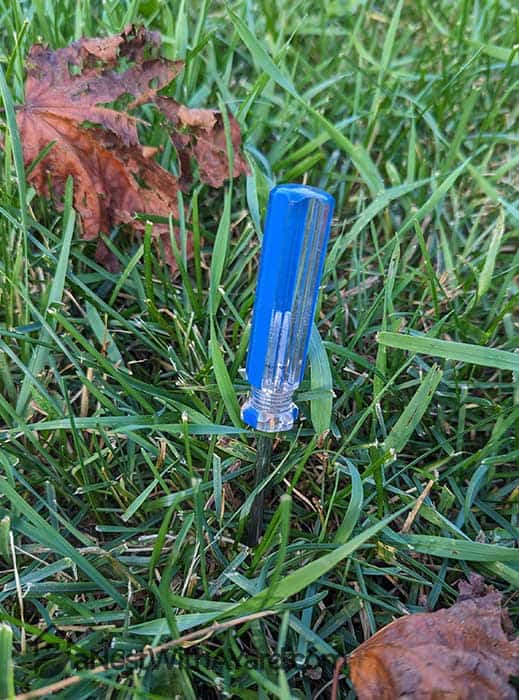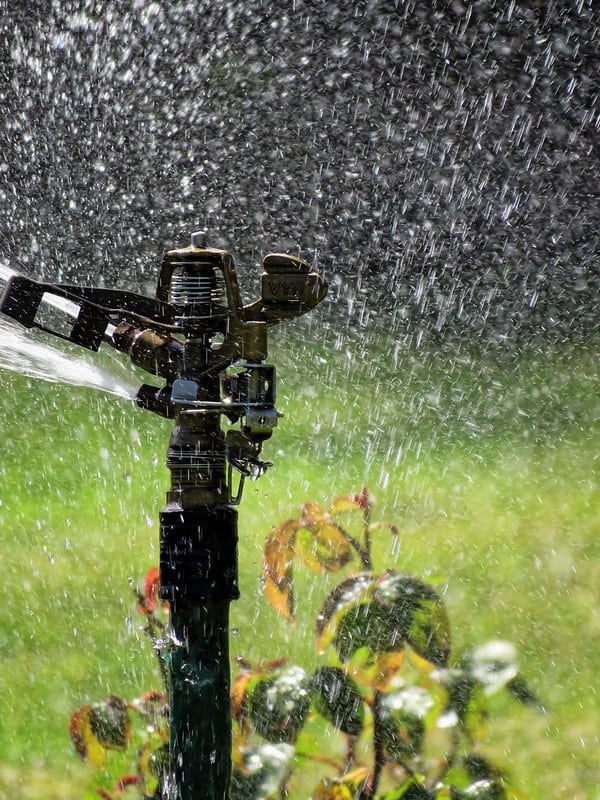You shouldn’t stop watering the lawn during fall. Grass needs water to develop its root system and receive valuable nutrients. Use a rain gauge and follow the weather forecast to ensure your grass receives 1 inch of water per week. The ideal time to stop watering lawns is when the ground freezes.
Inexperienced lawn owners often ask the same question: How often should I water my lawn in the fall, and when to stop?
That’s why I’ll tell you all you need to know about proper fall lawn care, including when to stop watering your lawn. This way, your grass will achieve optimal health and be well-prepared for the upcoming winter months. Stay with me!
Contents
When To Stop Watering Your Lawn In The Fall?

Your turf needs an adequate water supply, no matter the season. Proper watering makes a big difference in the health of your lawn. The photo above is courtesy of Charles Haynes.
So, how much water does your lawn generally need? Jackie Jordan, a commercial horticulture agent at Clemson University, states most turfgrasses require about an inch of water per week. She suggests using a rain gauge and following the weather forecast to determine whether your area is getting sufficient rainfall. When that is not the case, you must supplement rain with irrigation.
In general, as the weather grows colder and days shorter, the water evaporation process slows down, and your lawn requires less and less water. If your area receives sufficient rainfall during the fall months, you might not even need to water your lawn most of the time.
I took Jackie Jordan’s advice and added a rain sensor to my irrigation system. It helps me determine when my lawn needs watering year-round. As a result, I get a low water bill and a healthy lawn. That is not the only method, though.
How Do You Know If Your Lawn Is Getting Enough Water?

Experts from the Grounds Guys Landscaping & Lawn Care Services list three different methods you can use to determine whether your lawn receives enough water and if your sprinkler systems are set up correctly:
Screwdriver Test
If you can push a screwdriver 6 inches deep into your soil, you don’t have to irrigate. I deduced that this means that if you can’t, your soil is too dry and hard – so, it needs water.
Multiply & Divide Method
To set up the sprinkler system flow rate, multiply the square footage of your lawn by 0.62 gallons, then divide the result by the gallons per minute.
Empty Cans Method
Distribute empty cans around your lawn and turn on your sprinklers. Measure how long it takes to get 1 inch of water in each can.
I rely on the third method; the only difference is that I use plastic cups. Learn more in the video below:
The Best Fall Watering Tips & Tricks

Once I learned to determine how much water my turf needs, fall lawn care became easier, and I enjoyed a healthier lawn. Still, I want to share a few tips I got from the reputable Lawn Doctor Company experts. The photo above is courtesy of Acabashi.
- Modify your watering schedule in accordance with the cooler early fall temperatures. If the weather remains warm and dry, it is best to water grass twice a week.
- Do not stop watering your lawn abruptly.
- Stop watering grass only when the ground freezes. Frozen ground prevents water from reaching grass roots.
Professionals from the already-mentioned Grounds Guys Landscaping & Lawn Care Services company warn that caring for an overseeded or new lawn calls for a different tactic. New grass requires regular watering to establish its roots and grow. I learned this the hard way, so don’t make the same mistakes I did.
Why Is It Important To Continue Watering Your Grass In The Fall?

Professionals from the Green Earth Solutions lawn care company say it’s crucial to keep the soil under your grass moist through late fall, even if you live in the northern parts of the USA. This is especially important if you have cool-season grass like me because fall is a period of intense growth for this type of grass. If you deprive it of water, you will rob it of valuable nutrients and make it susceptible to diseases.
Generally speaking, grass continues to grow throughout the fall at the stolon level. Proper watering helps your grass recuperate from any summer heat stress damage and prepare for winter slumber and spring re-growth.
FAQs
Should grass be watered in the fall?
Grass should be watered in the fall to secure proper nutrient uptake and root system development. Professionals from the Green Earth Solutions company advise even northerners should not stop watering their lawns in early fall.
How do I know when to stop watering?
You know that it’s time to stop watering when the ground freezes. Scientists from the National Snow And Ice Data Center explain consistent freezing temperatures saturate the soil with ice, creating a waterproof concrete-like layer that prevents moisture from evaporating.
Final Thoughts
As you can see, unless you live on the outskirts of the rainforests, your grass requires watering through the late fall. You should gradually lower the amount of water in accordance with the weather changes. Stop watering the lawn when the ground freezes.
I hope this helps you. Please share the article to help others, too. If you need assistance, leave a comment.
